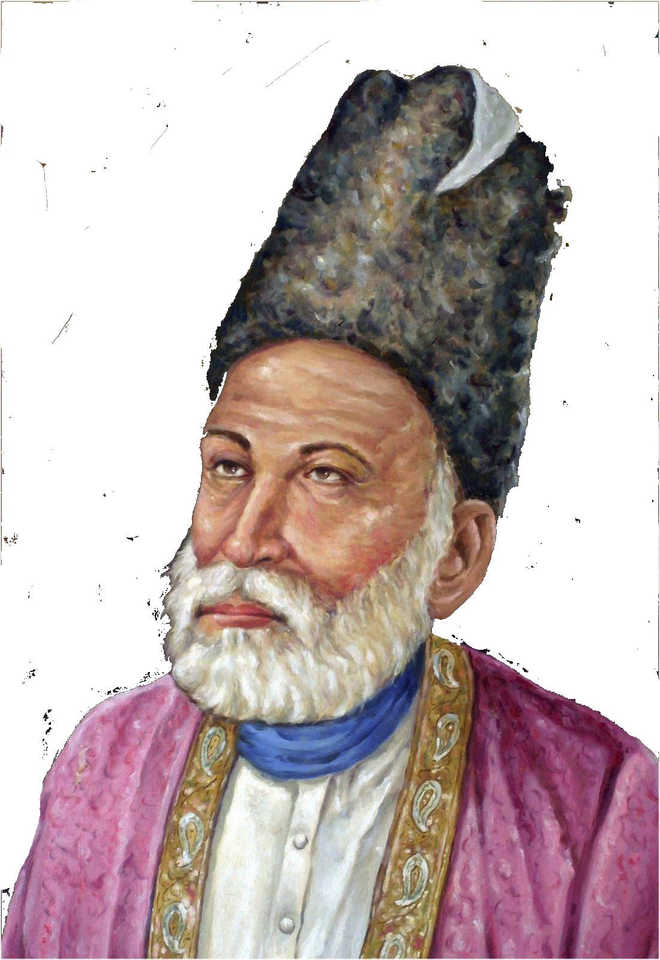
Mirza Ghalib
Sumit Paul
Salman Rushdie said, ‘To understand a person, one has to swallow the whole world.’ To paraphrase Rushdie, ‘To understand Mirza Ghalib, one has to swallow not just the world but the whole universe.’ Even after that, many a facet of Ghalib’s craftsmanship will remain unexplored. Such was his poetic genius and unfathomable depth of ideas. To be precise, Ghalib is an elusive enigma. Yet, a plethora of tomes and treatises can be found to descant upon the persona and poetry of Ghalib. The latest being, Delhi-based writer Hasan Abdullah’s, The Evolution of Ghalib.
Hasan’s book certainly deserves extra praise because despite a slew of books on Ghalib, barring Kalidas Gupta Reza’s chronological compilation of Ghalib’s Urdu poetry, Diwan-e Ghalib Kamil-nuskha-e Reza: Taareekhe Tarteeb Se in 1995, no writer or scholar ever attempted to study the evolution of Ghalib’s personality and his poetry. That Abdullah highlighted this dimension in his book even more adroitly and elaborately than the way Kalidas dealt with Ghalib’s chronological ascension as a poet, must be lauded.
A poet or a writer evolves with the passage of time and his/her works assume greater significance because ‘a poet continuously expands and ascends horizontally as well as vertically’, to quote Thomas Hardy, the last of the Victorians and first among the moderns.
Ghalib, like composer Mozart, was a precocious poet who started penning poetry at a very tender age. Though his very early poems showed the sparks of his future genius, they were after all, a greenhorn’s juvenile poetic endeavours. As time marched on, Ghalib’s poetry started becoming more mature, profound and also more and more unintelligible to the masses and even to those coevals and critics of Ghalib, who claimed to understand Urdu and Persian poetry.
Abdullah has painstakingly studied all phases of Ghalib’s evolution as a poet and his book shows that he burnt the midnight oil while writing it. Urdu poet and critic, Prof Dr Jagannath Azad, once said that “It was an uphill task for the writers and critics writing on Ghalib and Allama Iqbal regarding the inclusion and omission from both the stalwarts’ oeuvres. Eventually, writers and critics omitted the best and most profound couplets and included not-so-great couplets and quatrains from their literary works.’ On this count, Abdullah’s selection of Ghalib’s couplets is not just apposite and masterly, but also chronologically articulate.
He chose the best ones which quintessentially represented the four phases of Ghalib’s poetic sojourn, viz, Debut (D), Exploration (E), Bloom (B) and Twilight (T). Only the very best couplets were picked up to show his gradual development as a poet.
Ghalib, as we all know, wrote in Persian as well. In fact, he was proud of his Persian poetry and command of the language (Persian). But frankly speaking, his Persian doesn’t seem to be extraordinary to a native speaker or scholar of Persian. From the perspective of stylistics, his was sub-continental Persian, to be precise. The writer has judiciously not taken his Persian poetry into account.
Abdullah has enumerated upon the traditional symbols that Ghalib employed and how he subsequently augmented their corpus, context, contours, connotations and complexity. In other words, Ghalib infused and instilled new shades and hues of meanings into the traditional symbols and refurbished them.
The book is different in the sense that it speaks of Ghalib’s poetic and cerebral evolution in an interesting manner. Often such books become insipid to the readers. But this is an exception. Never does a reader or a critic find the book vapid.
Abdullah has maintained a uniform language and he’s been ably helped by A Naseeb Khan in this regard. The English translations are more or less lucid. But a few couplets demanded better and crisper translations. All in all, this book should appeal to the scholars as well as students of Ghalib’s varied and myriad poetry.
Urdu poet Ravish Siddiqui rather ruefully wrote, Samjha na Ghalib ko kisi ne aaj tak/Samjhane waale aaye, samjha ke chal diye (None has understood Ghalib till now/People came, interpreted his poetry and went away). Yaas Yagana Changezi almost caustically opined that Ghalib’s entire poetry was so deliberately serpentine that not a single couplet was worth-mentioning! Yet, the man is still read and interpreted by scholars with undiminished zeal and erudition.
Ghalib’s poetry is indeed almost uninterpretative at times, but it’s heartening to see that writers like Hasan Abdullah, Naseeb Khan and their ilk at least dare undertake the thankless task of interpreting a magnificently recondite poet like Mirza Asadullah Khan Ghalib.
Yet, many untouched nuances of Ghalib’s vast poetry are still to be elucidated. The scholastic interest in Ghalib and his hydra-headed poetry will never ebb away.



























